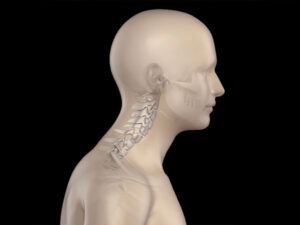

Let’s set the scene: You are hunched over your laptop or phone, your head leaning forward as if trying to peek into the screen’s soul.
You have probably heard that this forward head posture is bad for your neck and shoulders, but did you know it could also mess with the blood flow to your brain?
Yes, this seemingly innocent position can disrupt your brain’s vital supply line.
Today, we will dive into the science, the impacts, and some eyebrow-raising examples to show you how this common posture habit might be turning your noggin into a cranky, under-oxygenated mess.
This Article Covers:
- What Is Forward Head Posture and Why It Happens
- Anatomy 101: Understanding Blood Flow to the Brain
- How Forward Head Posture Affects Blood Circulation
- The Domino Effect: Neck Tension, Vessel Compression, and Reduced Oxygen
- Real-Life Scenario: How Jane’s Posture Led to Brain Fog and Fatigue
- The Scientific Evidence: What Studies Reveal
- Why All of This Matters
What Is Forward Head Posture and Why It Happens?
Before we jump into the gory details, let’s define what forward head posture (FHP) actually is.
Picture a turtle slowly emerging from its shell.
That is essentially what your head is doing when it juts forward past your shoulders.
This posture typically occurs because of modern lifestyle habits: prolonged computer use, smartphone scrolling, and even slouching while binge-watching Netflix.
FHP is more than just an aesthetic problem; it changes the biomechanics of your entire upper body.
The muscles in your neck, particularly the sternocleidomastoid and trapezius, are forced to work overtime to support your head.
The more your head tilts forward, the more strain these muscles endure, and that’s where the trouble starts.
Anatomy 101: Understanding Blood Flow to the Brain
Let’s unpack how posture—specifically forward head posture—can choke the brain’s oxygen party:
Two Vital Arteries, One Mission:
Blood reaches the brain through the carotid arteries (running up the front of your neck) and the vertebral arteries (threaded through the bony canals of your cervical vertebrae). These are the brain’s life supply highways.
Carotids and Compression:
In forward head posture (FHP), neck muscles like the sternocleidomastoids tighten, and soft tissues around the carotid sheath can compress the artery. This reduces blood flow efficiency, as confirmed in studies published by Clinical Anatomy and The European Journal of Vascular and Endovascular Surgery.
Vertebral Artery Vulnerability:
The vertebral arteries pass through tiny holes in your cervical vertebrae (foramina transversaria). With poor posture, especially if accompanied by cervical lordosis flattening, these bony corridors narrow and kink the artery, as noted in Spine (2020). Less room = less blood.
Symptoms You Can’t Ignore:
Reduced cerebral blood flow from FHP is linked to dizziness, lightheadedness, and cognitive fog. A 2019 study in the Journal of Manipulative and Physiological Therapeutics even found mild vertebrobasilar insufficiency in patients with chronic postural abnormalities.
Long-Term Brain Drama:
Chronic postural vascular compression may contribute to neurovascular tension and reduced oxygen delivery—two precursors for brain fatigue and poor concentration.
So yes, bad posture is not just a pain in the neck—it is a brain drain, literally.
How Forward Head Posture Affects Blood Circulation?
Okay, here is where things get alarming.
When you have forward head posture, the muscles in your neck tighten, and your cervical spine compresses.
This compression can pinch or restrict the carotid and vertebral arteries.
Imagine kinking a garden hose; the water flow slows to a trickle.
The same thing can happen to your blood flow.
According to a study published in Frontiers in Neurology, poor posture, particularly forward head posture, can reduce the blood supply to the brain.
The reduced circulation not only decreases oxygen but also limits the delivery of nutrients crucial for brain health.
Over time, this can lead to symptoms like tension headaches, dizziness, brain fog, and even cognitive decline.
The Domino Effect: Neck Tension, Vessel Compression, and Reduced Oxygen
Forward head posture (FHP) is more than just a neck issue; it sets off a chain reaction that affects the entire body. Here’s how it happens:
1. Increased Muscle Tension:
When your head leans forward, the neck muscles, particularly those at the back, must work harder to support the additional weight.
For every inch the head moves forward, the neck muscles experience an extra 10 pounds of force. Over time, this excessive strain leads to muscle tightness, inflammation, and chronic pain.
As per Trinity Health of New England, prolonged FHP can cause severe muscular fatigue and discomfort.
2. Vessel Compression:
Tightened neck muscles can compress vital blood vessels, particularly the vertebral arteries, which pass through small openings in the cervical vertebrae.
When these arteries are compressed, blood flow to the brain is restricted.
According to research published in the National Library of Medicine, restricted vertebral artery circulation can lead to reduced oxygen supply, affecting brain function and overall health.
3. Oxygen Deprivation:
When blood flow is compromised, the brain doesn’t receive enough oxygen, leading to symptoms like brain fog, dizziness, and impaired focus.
Chronic oxygen deprivation can even contribute to long-term cognitive decline.
A study published in Scientific Reports by Nature found that forward head posture can weaken key postural muscles and reduce lung function, further limiting oxygen intake.
Additionally, poor posture can negatively affect cardiorespiratory fitness by obstructing normal breathing patterns, making it harder for the body to maintain proper oxygen circulation.
To counteract these effects, posture correction exercises, ergonomic adjustments, and strengthening techniques can help restore alignment, reduce tension, and improve blood circulation.
As studies suggest, early intervention is key in preventing the long-term consequences of FHP.
Real-Life Scenario: How Jane’s Posture Led to Brain Fog and Fatigue?
Meet Jane, a 30-year-old graphic designer.
Jane (a resident of California) spent hours each day hunched over her computer, her head pushed forward in concentration.
She often felt tired, had difficulty focusing, and experienced frequent headaches.
Thinking it was just stress, she ignored the symptoms until a physical therapist pointed out her forward head posture.
Once she began to address her posture, her symptoms improved dramatically.
Jane’s case is not unique. Many people experience similar issues, often unaware that their posture could be to blame.
It is a subtle, sneaky problem, but the effects are very real.
The Scientific Evidence: What Studies Reveal?
You might be thinking, “Is this really a thing, or is it just another health fad?”
Well, the science is pretty solid.
Research from The Journal of Clinical Neuroscience has shown that people with chronic neck pain, often due to poor posture, have reduced blood flow through the vertebral arteries.
Another study in Surgical Technology International demonstrated that forward head posture can add up to 60 pounds of pressure on the cervical spine, further compressing the blood vessels.
Dr. Michael Evans, a leading neurologist, states, “The compression of neck arteries due to poor posture can lead to insufficient oxygenation of the brain, which is a serious concern for long-term neurological health.”
Why All of This Matters?
At this point, you might be asking, “So what?”
Well, reduced blood flow to the brain is not something to brush off lightly.
Your brain’s efficiency and overall health depend on a steady supply of oxygen and nutrients.
Chronic deprivation can contribute to more serious neurological issues over time.
Best Forward Head Posture Fix may seem like a minor inconvenience or a cosmetic issue, but its impact on your brain’s health is significant.
From cognitive function to your emotional well-being, the way you hold your head can shape your overall quality of life.
References:


